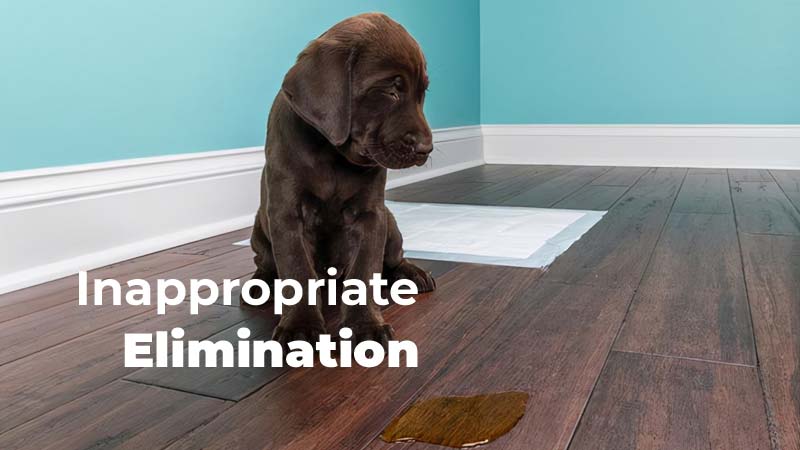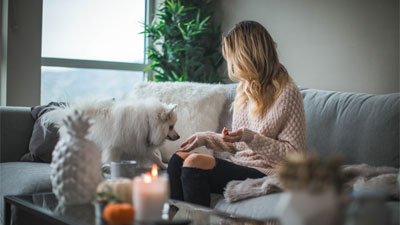- Size
- Smallest
- Small
- Small to Medium
- Medium
- Large
- Giant
- Characteristics
- Smartest
- Hypoallergenic
- Fluffy
- Best Guard
- Best Family
- Best for Kids
- Low Shedding
- Healthiest
- Police Dogs
- Most Calm
- Quietest
- Color
- White
- Black
- Grey
- Brown
- Blue
- Red
- Coat
- Hairless
- Short
- Long
- Origin
- Japan
- China
- Australia
- Germany
- Italy
- United States
- France
- Group
- Hound
- Terrier
- Herding
- Toy
- Working
- Sporting
Addressing Inappropriate Elimination in Dogs

For dog owners, encountering inappropriate elimination behaviors in their beloved pets can be both frustrating and perplexing. Whether it's a puppy or an older dog, the sight of accidents indoors raises concerns and demands immediate attention. Addressing this issue effectively requires a multi-faceted approach that encompasses understanding the root causes, diligent training, and, if necessary, seeking professional guidance.
Causes of Inappropriate Elimination
Understanding why a dog eliminates indoors is pivotal in addressing the behavior. It often boils down to two primary factors: health concerns and behavioral issues.
1. Health Concerns
The first step in tackling inappropriate elimination is ruling out potential health problems. Conditions like urinary tract infections, diabetes, or other medical issues can lead to accidents indoors. A visit to the veterinarian is crucial to rule out these underlying health issues.
2. Behavioral Reasons
Dogs might exhibit this behavior due to various behavioral reasons:
Anxiety and Stress: Dogs, much like humans, can experience anxiety and stress. Changes in the environment, separation anxiety, or unfamiliar situations can trigger inappropriate elimination.
Territorial Marking: Marking territory is a natural behavior in dogs. They might urinate indoors to assert their territory.
Incomplete Housebreaking: Young puppies often require consistent training to learn appropriate bathroom behavior. However, even adult dogs might revert to eliminating indoors due to inconsistent training.
Steps to Address Inappropriate Elimination
Consulting a Veterinarian: A veterinary check-up should be the initial step to rule out health concerns.
Identifying the Cause: Observing the dog's behavior and patterns can help pinpoint the specific reason for inappropriate elimination.
Behavior Modification Techniques: Employing positive reinforcement, consistency, and re-establishing housebreaking techniques are pivotal in addressing this behavior. Consistency and patience play key roles in the success of any training regimen.
Training Aids: Tools like doggy doorbells or setting a regular routine for bathroom breaks can aid in training the dog to communicate its needs effectively.
Tips for Effective Training and Prevention
Consistency and Patience: Emphasize the need for a consistent approach in training, coupled with patience and positive reinforcement.
Establishing a Routine: Creating a consistent schedule for feeding, walks, and bathroom breaks helps in instilling good habits.
Cleaning and Odor Removal: Thoroughly clean and eliminate odors from areas where accidents occur to prevent repeat incidents.
Seeking Professional Help
If the problem persists despite efforts, seeking professional guidance is wise. A dog trainer or behaviorist can offer tailored solutions and a structured plan to address the specific needs of the dog.
Conclusion
Inappropriate elimination in dogs demands patience, understanding, and a systematic approach. By addressing potential health concerns, employing consistent training methods, and seeking professional help if necessary, dog owners can effectively overcome this challenging behavior, fostering a happier and more harmonious relationship with their furry companions.
You May Also Like
 Help & AdviceUnderstanding and Addressing Separation Anxiety in Dogs
Help & AdviceUnderstanding and Addressing Separation Anxiety in Dogs Dog BehaviorThe Reasons Behind Canine Digging and Effective Solutions
Dog BehaviorThe Reasons Behind Canine Digging and Effective Solutions Dog BehaviorUnderstanding Dog Chewing: Causes and Solutions
Dog BehaviorUnderstanding Dog Chewing: Causes and Solutions Help & AdvicePet Compatibility Test: Finding Your Ideal Animal Companion
Help & AdvicePet Compatibility Test: Finding Your Ideal Animal Companion Dog Training Tips5 Things to Know About Puppy Behavior Training Mistakes
Dog Training Tips5 Things to Know About Puppy Behavior Training Mistakes Dog Training TipsHow to Train a Dog To Poop and Pee in One Spot
Dog Training TipsHow to Train a Dog To Poop and Pee in One Spot